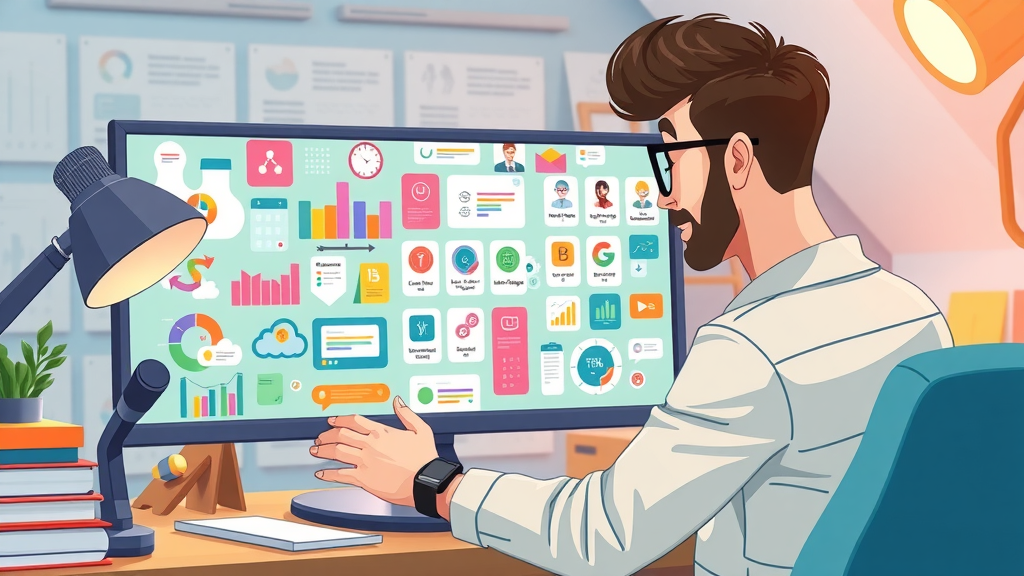Did you know that companies with a well-defined content marketing & blogging strategy generate over 67% more qualified leads per month? In a digital landscape that’s more competitive than ever, building a robust content marketing and blogging plan is not just an option—it's a necessity if you want your brand to thrive, connect meaningfully with your target audience, and drive measurable results. In this guide, you’ll learn practical steps, expert tips, and real-world examples to craft a content strategy that puts you ahead in 2024 and beyond.
Why Content Marketing & Blogging Drive Today's Digital Success
- Did you know that companies with a well-defined content marketing & blogging strategy generate over 67% more qualified leads per month? Discover why content marketing & blogging are pivotal for successful marketing strategy in 2024.

Content marketing & blogging have transformed into the cornerstone of any successful marketing strategy . Brands that embrace a holistic approach aren’t just sharing stories—they’re building communities, establishing trust, and consistently nurturing their potential customers through valuable information. The data shows that businesses investing in blog content outperform their competition by providing answers to real customer questions, establishing thought leadership, and increasing brand awareness . Today, it’s not enough to just have a website—your content must solve problems, build rapport, and drive ongoing engagement, especially across critical channels like social media and video content.
What does effective content look like? Top-performing brands use a blend of blog posts , social media marketing, video content, and even case studies to reach and retain their audience. By leveraging these content formats, they address every stage of the buyer’s journey, nurturing both awareness and loyalty. In the ever-shifting digital space, the brands that publish high-quality blog content and master strategy adaptation continue to outpace those relying solely on traditional paid ads.
What You'll Gain from Mastering Content Marketing & Blogging
- Get clear, actionable steps for crafting a high-impact content marketing & blogging strategy; see top content strategy examples, learn to identify your target audience, and unlock the secrets of content marketer success.
"Content marketing & blogging done right isn’t just promotional—it’s transformational for both brands and consumers."
By mastering content marketing & blogging , you unlock the keys to brand awareness , sustainable site traffic, and real business results. You’ll learn how to create a content marketing plan that delivers, supported by data-driven insights and effective content strategy frameworks. We'll cover everything from blog post planning and target audience research, to using the right types of content for your goals and metrics you can actually track for ongoing improvement. As you proceed, you’ll learn to think like a content marketer , ensuring every piece of content has purpose, reach, and measurable impact.
As you refine your approach, it’s also important to understand how to measure the true impact of your efforts. For a deeper dive into tracking performance and demonstrating value, explore these marketing analytics and ROI strategies for content marketers that can help you optimize every stage of your content plan.
Understanding the Core: Content Marketing, Blogging, and Effective Marketing Strategy
Defining Content Marketing & Blogging in Modern Marketing Strategy
- Breakdown of what content marketing & blogging truly entail, including essential blog content elements.

Content marketing is much more than simply posting articles online. At its core, it’s a deliberate marketing strategy that leverages valuable blog content , video content , infographics, and social media posts to move potential customers through the funnel. Blogging is a foundational piece—think of it as the engine driving your organic reach, SEO results, and thought leader reputation. An effective modern blog doesn’t just share news; it answers real questions, supports every stage of the buying journey, and engages your target audience with insightful, actionable, and consistent content.
Elements of essential blog content include a compelling headline, reader-focused body, optimized keywords for search engine visibility, strong internal links, and multimedia such as images or videos. Blog content should reflect a content strategy that directly supports business goals and resonates with your ideal buyer persona. Whether creating case studies , how-to guides, or industry trends, every blog post should deliver value.
The Role of Content Strategy in a Comprehensive Marketing Plan
- Explore why a unified content marketing strategy is critical for content marketers.
A strong content strategy acts as the blueprint for content marketers . It ensures each blog post , social update, or video aligns with your core marketing plan . When implemented consistently, content marketing connects all stages of the customer journey—creating awareness, demonstrating expertise, and nurturing trust—while supporting SEO and increasing visibility across search engines .
If you want to achieve effective content marketing results in 2024, you must unify your planning. This means connecting every piece of content —from long-form blogs to fast-moving social media—to your business objectives. Modern marketing teams break down silos by having regular content strategy meetings and using tools that synchronize campaigns across all channels and formats, including paid ads and earned media. This cohesion delivers stronger brand messaging and ultimately, better ROI for your marketing efforts.
Mapping Out Your Content Marketing & Blogging Goals for Maximum Reach
Aligning Business Objectives with Content Marketing Strategy
- Connecting target audience insights, blog posts planning, and social media marketing goals.
To ensure your content marketing & blogging drives real impact, it’s critical to align your efforts with overarching business goals. Start by defining what success looks like—whether it’s brand awareness, lead generation, or customer retention. Use customer research to develop a clear buyer persona , uncovering audience preferences and pain points that guide your blog post topics and content format strategy.
Next, translate these insights into a unified content marketing strategy . For example, if your goal is to grow your email list, plan regular in-depth blog content offering downloadable resources. If expanding reach is the priority, amplify your efforts by launching a social media marketing campaign that repurposes your most popular blog posts into shareable infographics or short video content for platforms like Instagram or TikTok.
Measuring Success: Key Metrics Content Marketers Track
| Metric | What It Measures | Why It Matters |
|---|---|---|
| Website Traffic | Number of visitors from blog content, social, and search engines | Shows content reach and SEO effectiveness |
| Engagement | Shares, comments, time on page, bounce rate | Indicates audience interest and relevance |
| Conversion Rates | Leads, sign-ups, downloads from specific blog content | Reveals impact of content on business goals |
| ROI | Revenue generated vs. investment in content | Measures overall strategy effectiveness |

Content marketers consistently track these metrics to adapt and optimize their content marketing plan . For instance, analyzing which blog posts drive the most organic traffic helps guide future content topics, while engagement rates highlight what resonates with your target audience . Conversion tracking is essential to justify ongoing investment, and calculating ROI provides a tangible link between content efforts and bottom-line results. Tools like Google Analytics, HubSpot, and social insights dashboards can automate much of this analysis, freeing your team to focus on content creation and strategy.
Identifying and Understanding Your Target Audience to Refine Your Content Marketing & Blogging
Building Reliable Audience Personas as a Content Marketer
- Factors to include: age, interests, pain points, and preferred content formats.

Success in content marketing & blogging hinges on understanding precisely who you’re speaking to. Content marketers build in-depth audience personas by gathering demographic data (like age and location), mapping out interests and typical pain points, then identifying which content formats their audience prefers. This might mean combining quantitative data (site analytics, social media insights) with qualitative feedback (surveys, interviews).
For example, if your primary buyer persona is a 30- to 40-year-old professional, their pain points might include time constraints and a desire for actionable, easily digestible advice. This insight shapes not only your topics but also how you deliver information through blog content, emails, or micro-learning video content on social media. The result is a marketing strategy grounded in relevance and empathy—two pillars of effective content marketing.
Choosing the Right Channels: Social Media, Blog Content, and Beyond
- Evaluating which social media and blog post formats suit your audience.
A winning content marketing strategy requires selecting the best channels to reach your target audience. Start by identifying where your personas spend time online: are they more active on LinkedIn, Instagram, YouTube, or niche forums? Research which content formats (how-to guides, listicles, short videos) drive the most engagement within those platforms.
Diversifying your approach allows you to meet your audience where they are. For B2B audiences, LinkedIn blog content and in-depth articles enhance thought leadership; for B2C, engaging stories on Facebook or Instagram Stories paired with dynamic video content might resonate more. Data-driven experimentation helps you refine your blog content and social strategy, ensuring every piece of content is delivered where and how your audience wants it.
Crafting a Data-Driven Content Marketing Strategy: From Blog Content to Video Content
Selecting Types of Content: Blog Content, Video Content, Social Media & More
- Advantages of different content formats for effective content marketing.

The most effective content marketing & blogging strategies leverage a mix of blog content , video content , podcasts, infographics, and case studies. Each content format offers unique strengths: blog posts drive organic search traffic and establish authority; short videos excel at engagement and retain attention; infographics make complex ideas visually digestible; case studies and customer stories build credibility and nurture potential customers through the marketing funnel.
The secret is to tailor types of content to your goals and audience preferences. Experiment with different formats, measure which ones generate shares and conversions, and balance evergreen pieces (timeless blog content) with timely updates (industry news or trends via social channels). This inclusive approach strengthens your content marketing plan, creating multiple entry points for audience engagement.
Developing a Content Calendar to Support Your Content Marketing Plan
- How to schedule blog posts, social media marketing, and video content for consistency.
A comprehensive content marketing strategy relies on a well-organized calendar. Start by mapping out key publishing dates for your blog content , scheduling regular social media updates, and planning in advance for video content releases. This ensures steady engagement, builds audience anticipation, and prevents last-minute scrambles that lead to inconsistent messaging.
Modern teams use tools like Trello, Asana, or CoSchedule to coordinate and visualize blog post deadlines, social campaigns, and cross-channel promotions. A consistent schedule also helps you plan for milestones (product launches, holidays, or campaign cycles) and encourages proactive brainstorming. For every content marketer , the content calendar is the backbone of operational efficiency and repeatable marketing success.
SEO Tactics for Content Marketers: Strengthen Your Content Marketing & Blogging Results
Keyword Research & On-Page Optimization in Blog Posts
- How to select winning keywords and apply them to your blog content for top search results.
Keyword research is the launchpad for higher search engine rankings. As a content marketer , begin by identifying the high-intent terms your target audience actually searches for—using tools like Google Keyword Planner, SEMrush, or Ahrefs. Incorporate these keywords naturally within blog titles, subheadings, meta descriptions, and throughout your blog content for optimal on-page SEO.
Beyond keywords, focus on on-page optimization strategies: write compelling meta titles, add descriptive image alt text, use internal linking to related posts, and maintain a readable structure with headers and short paragraphs. Quality, relevance, and clarity are rewarded by search engines. Consistently optimizing each blog post will amplify your organic reach, build authority, and deliver compounding returns over time.
Link Building and Promotion Across Social Media & Blog Content
- Effective strategies to amplify reach through social media marketing, guest blogging, and paid ads.
"Great content may get found, but strategic content marketing gets heard and acted upon."
Promoting your blog content is just as critical as creating it. Content marketers should build a network of backlinks by guest posting on reputable sites, collaborating with thought leaders, and sharing on social channels where their audience is most active. Using paid ads or promoted posts on platforms like LinkedIn and Facebook can further boost distribution, especially for high-value content pieces or launches.
The synergy between blog and social media marketing extends your reach and authority, increasing the likelihood of your content being seen, shared, and linked to by other sites. Combining organic tactics (like storytelling, influencer mentions) with smart paid ads keeps your marketing efforts agile and able to adapt to any algorithm shifts or changes in audience behavior.
Amplifying Results: How Social Media Marketing Integrates with Content Marketing & Blogging
Leveraging Social Media Platforms for Content Distribution
- Tailoring your message and format to each social media platform as part of your content strategy.
Smart content marketers diversify their distribution strategy by sharing blog content and multimedia across leading social media platforms. Each channel requires a tailored approach: Twitter thrives on concise updates and threads; Instagram rewards visuals and short video content; LinkedIn is ideal for thought leadership and in-depth articles; Facebook extends reach through shareable posts and community engagement.
Successful distribution means matching message, timing, and content format to platform-specific behaviors and audience expectations. Integration of blog content links in posts, stories, and feeds, plus the strategic use of hashtags and paid ads, drives both engagement and site traffic. Social media marketing acts as the megaphone for your content marketing strategy, amplifying your voice and building a loyal online community.
Harnessing the Power of Video Content & Visuals
- Why video content and visual storytelling belong in every content marketer’s toolkit.

Incorporating video content and vibrant visuals dramatically increases the effectiveness of your content marketing . Studies show that posts with visuals receive significantly higher engagement—and short-form videos in particular dominate social platforms. For content marketers , this means turning popular blog posts into animated explainers, tutorials, or behind-the-scenes vlogs to meet the rising demand for multimedia learning.
Visual storytelling allows you to distill complex ideas into memorable narratives, increase shareability, and foster greater emotional connection. Use a mix of formats—live videos, reels, GIFs, infographics—to keep your content fresh and expand your audience reach across all platforms.
Repurposing and Diversifying: Types of Content to Boost Any Content Marketing & Blogging Plan
- Turning blog posts into infographics, podcasts, videos—maximize every idea’s reach.

One of the most powerful tactics for content marketers is repurposing high-performing blog content into a variety of formats. A single insightful article can become an infographic for Pinterest, a podcast episode for Spotify, short video content for YouTube Shorts, or a series of tweets for X. Repurposing ensures every piece of content achieves maximum reach and delivers value across different audience preferences and platforms.
This strategy saves time, preserves creative resources, and ensures a unified brand message everywhere your potential customers engage. Over time, repurposing builds a robust content pipeline—helping your content marketing & blogging strategy stay consistent, sustainable, and scalable.
Scaling Up: How Content Marketers Organize Team Roles and Tools
Essential Tools for Content Marketing & Blogging Success
| Need | Recommended Tools |
|---|---|
| Content Creation & Editing | Grammarly, Google Docs, Hemingway App |
| Blog Publishing & CMS | WordPress, Ghost, HubSpot CMS |
| SEO & Analytics | Yoast, Google Analytics, SEMrush |
| Social Media Scheduling | Buffer, Hootsuite, Later |
| Collaboration | Asana, Trello, Slack |
Effective Collaboration Between Content Marketers
- Streamlining workflows between marketers, designers, and writers for content strategy execution.

Coordinated teamwork is the hallmark of a scalable content marketing & blogging strategy . Effective marketers implement project management tools to streamline every step, from ideation to publication. Writers, editors, graphic designers, and social media managers collaborate in real-time, reducing bottlenecks and ensuring that every blog post and marketing campaign launches on schedule.
Clear communication channels and documented workflows empower every member—whether reviewing content, updating drafts, or launching paid ad campaigns. Leveraging digital tools enhances transparency and accountability, ensuring your marketing plan remains both agile and aligned with business goals.
Adapting Your Content Marketing Strategy: Trends, Challenges, and Future Proofing
Emerging Trends for Content Marketers & Blogging
- AI content tools, short video content, new SEO techniques and influencer strategies shaping effective content marketing.

The pace of digital change is staggering—but top content marketers are already embracing the trends that shape tomorrow’s strategies. AI-powered content creation tools can now generate outlines, assist with blog content drafts, and optimize messaging for different audience segments. Meanwhile, the explosive rise of short video content has pushed marketers to rethink media marketing, creating snappier content designed for TikTok, Instagram Reels, and YouTube Shorts.
New SEO techniques—such as semantic search optimization, answer box targeting, and voice search—are also evolving rapidly. Influencer collaborations and user-generated content campaigns add further authenticity, helping brands stand out as thought leaders in saturated markets. Stay open to experimentation and be ready to adapt your content marketing plan as these trends continue to shape the field.
Overcoming Common Challenges in Content Marketing & Blogging
- Burnout from relentless content creation cycles and tight deadlines
- Inconsistent posting due to lack of planning or resources
- Unclear marketing plan leading to scattered messaging
- Difficulty measuring ROI for social media marketing and blog content
- Falling behind on trends or audience preferences

Every content marketer faces obstacles on the path to effective content marketing. Common pitfalls include burnout , which can be managed by detailed planning and batch content creation; inconsistency, avoided by using a shared content calendar; and lack of clear objectives, solved with well-documented marketing strategies. Accurate measurement tools help track performance, and ongoing education about trends prevents stagnation. The best teams thrive by being adaptable, learning from failures, and staying committed to continual strategic improvement.
Putting It All Together: Sample Content Marketing Plan
| Week | Blog Content | Social Media | Video Content | Repurposed Formats |
|---|---|---|---|---|
| Week 1 | How-To Guide (Monday) | LinkedIn & Twitter Teaser (Mon-Wed) | Short Explainer (Fri) | Infographic (Saturday) |
| Week 2 | Industry Trends (Wednesday) | Facebook Live Recap (Thursday) | Podcast Clip (Friday) | Instagram Stories (Sat-Sun) |
| Week 3 | Case Study (Tuesday) | Discussion Thread (LinkedIn Wednesday) | Testimonial Video (Friday) | Pinterest Board (Sunday) |
| Week 4 | Listicle (Monday) | Instagram Carousel (Wednesday) | Q&A Video (Thursday) | Newsletter Feature (Friday) |
People Also Ask: Addressing Common Content Marketing & Blogging Questions
What is a content marketing blog?
- A content marketing blog is a digital platform dedicated to publishing articles, guides, and resources that educate, engage, and drive traffic as part of a larger content marketing strategy.
What is the difference between content marketing and blogging?
- While blogging refers to publishing articles regularly, content marketing encompasses a wider range of tactics including blog posts, social media, video content, and more, all aimed at driving targeted marketing outcomes.
What are the 3 C's of content marketing?
- The 3 C’s are: Creation (crafting valuable content), Curation (collecting and sharing relevant content), and Consistency (delivering content regularly across your marketing channels).
How do I start content marketing?
- Identify your target audience, set clear goals, develop a content marketing plan, create valuable blog content, and consistently measure your results to fine-tune strategy.

Frequently Asked Questions about Content Marketing & Blogging
-
How often should I blog for effective content marketing?
For most brands, publishing new blog content at least once a week ensures steady engagement and ongoing SEO growth, but consistency and quality remain more important than sheer volume. -
Which types of content work best for B2B vs B2C?
B2B brands succeed with in-depth guides, whitepapers, and LinkedIn articles; B2C brands benefit from personal stories, user-generated content, and highly visual, shareable social posts. -
How do I measure ROI in blog content and social media marketing?
Track metrics such as lead generation, conversion rates, website traffic sources, and sales attributed to blog content and social campaigns, using tools like Google Analytics or HubSpot. -
What’s the best approach to combine paid ads with blog content?
Promote your highest-value blog posts with targeted paid ads across social channels, retargeting visitors who’ve engaged with your content but haven’t yet converted. -
Should small businesses invest in content marketing and blogging?
Yes—content marketing delivers long-term ROI, drives organic search visibility, and builds credibility without demanding huge ad budgets. Small businesses benefit especially from consistent, trustworthy blog content.

Key Takeaways for a Winning Content Marketing & Blogging Strategy
- Align your content strategy with clear business objectives.
- Understand your target audience with detailed personas.
- Plan consistently with a content calendar.
- Diversify with different content types (blog, video, infographics).
- Track performance with actionable metrics.
- Embrace change by staying current on industry trends.
If you’re ready to take your content marketing and blogging to the next level, consider exploring broader strategies that can help you adapt to seasonal trends and market shifts. Discover how to align your campaigns with timely opportunities and keep your brand top-of-mind year-round by reviewing these seasonal promotional marketing insights for content marketers . By integrating these advanced approaches, you’ll be equipped to maximize engagement, drive consistent results, and future-proof your content strategy in an ever-evolving digital landscape.
Ready to Accelerate Your Content Marketing & Blogging?
- Supercharge your strategy today: Get A Free £500 Blog Setup
To deepen your understanding of content marketing and blogging strategies, consider exploring the following resources:
- “Blogging vs. Content Marketing: Differences and Benefits” ( wix.com )
This article clarifies the distinctions between blogging and content marketing, highlighting how each serves unique roles within a comprehensive marketing strategy.
- “Blogging is the Foundation of Content Marketing” ( brickmarketing.com )
This piece emphasizes the pivotal role of blogging in content marketing, detailing how it enhances brand awareness, drives web traffic, and improves SEO rankings.
By delving into these resources, you’ll gain valuable insights to refine your content marketing and blogging approach, ensuring alignment with your business objectives and audience needs.
 Add Row
Add Row  Add
Add 




Write A Comment